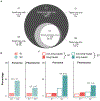A follow-up on quantitative and qualitative olfactory dysfunction and other symptoms in patients recovering from COVID-19 smell loss
- PMID: 35398877
- PMCID: PMC11016179
- DOI: 10.4193/Rhin21.415
A follow-up on quantitative and qualitative olfactory dysfunction and other symptoms in patients recovering from COVID-19 smell loss
Abstract
Background: Sudden smell loss is a specific early symptom of COVID-19, which, prior to the emergence of Omicron, had estimated prevalence of ~40% to 75%. Chemosensory impairments affect physical and mental health, and dietary behavior. Thus, it is critical to understand the rate and time course of smell recovery. The aim of this cohort study was to characterize smell function and recovery up to 11 months post COVID-19 infection.
Methods: This longitudinal survey of individuals suffering COVID-19-related smell loss assessed disease symptoms and gustatory and olfactory function. Participants (n=12,313) who completed an initial survey (S1) about respiratory symptoms, chemosensory function and COVID-19 diagnosis between April and September 2020, were invited to complete a follow-up survey (S2). Between September 2020 and February 2021, 27.5% participants responded (n=3,386), with 1,468 being diagnosed with COVID-19 and suffering co-occurring smell and taste loss at the beginning of their illness.
Results: At follow-up (median time since COVID-19 onset ~200 days), ~60% of women and ~48% of men reported less than 80% of their pre-illness smell ability. Taste typically recovered faster than smell, and taste loss rarely persisted if smell recovered. Prevalence of parosmia and phantosmia was ~10% of participants in S1 and increased substantially in S2: ~47% for parosmia and ~25% for phantosmia. Persistent smell impairment was associated with more symptoms overall, suggesting it may be a key marker of long-COVID illness. The ability to smell during COVID-19 was rated slightly lower by those who did not eventually recover their pre-illness ability to smell at S2.
Conclusions: While smell ability improves for many individuals who lost it during acute COVID-19, the prevalence of parosmia and phantosmia increases substantially over time. Olfactory dysfunction is associated with broader persistent symptoms of COVID-19, and may last for many months following acute COVID-19. Taste loss in the absence of smell loss is rare. Persistent qualitative smell symptoms are emerging as common long-term sequelae; more research into treatment options is strongly warranted given that even conservative estimates suggest millions of individuals may experience parosmia following COVID-19. Healthcare providers worldwide need to be prepared to treat post COVID-19 secondary effects on physical and mental health.
Conflict of interest statement
Conflict of interest
Prof. Hayes is a co-founder of Redolynt LLC. Prof. Philpott is a trustee of the charity Fifth Sense. None of the other authors have any conflicts to disclose.
Figures




References
-
- CDC. Coronavirus Disease 2019 (COVID-19) in the U.S. Centers for Disease Control and Prevention Published July 25, 2020. Accessed July 30, 2020. https://www.cdc.gov/coronavirus/2019-ncov/cases-updates/cases-in-us.html
MeSH terms
Grants and funding
LinkOut - more resources
Full Text Sources
Medical
Miscellaneous

